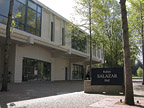
Precision Control = Better Efficiency
Principal engineer Tony Costa and design engineer Edmund Cancio of Costa Engineers, Inc., were well aware of the campus goals and budget when selecting the characterized control valves and actuators that would be used on the VAV reheat coils, dampers, and chilled water cooling coils. It was very important, according to Costa, that valves and actuators be able to carefully track flow through the coils.The operation of the VFDs on the heating and cooling systems is based on flow through the control valves. Costa knew from experience that Belimo's characterized control valves (CCVs) were extremely accurate and they, along with direct connected actuators and a DDC system, would enable the university to continuously monitor every valve in the building and adjust pump flow rates based on valve position. Minimum required flow rate is attained when all zones are satisfied and no control valve is more than 90% open. Costa Engineers was determined to make every horsepower count.
This accuracy, said Tony Costa, is a function of two characteristics, both of which result in a linear heat output. First, actuators for the CCVs are direct-coupled, eliminating typical mechanical linkage, which may, over time, impede the repeatability of the valve.
Second, the CCV has a wide variety of Cv values for each valve size. Multiple values will allow an engineer to easily size valves closer to the pipe size resulting in less time and money spent on pipe reductions, while still achieving accurate control. Costa was able to select the same CCV valve on several different coils and continually maintain the same pressure drop across the valve, which was absolutely critical in this application. Typical variations in pressure would cause other valves to hunt, resulting in less system accuracy.
Typically, system VFDs react to an "average" in pressure change, rather than the individual position of each valve. However, at the Ruben Salazar building, operators know exactly which valve is at its worst-case scenario and can drive the pumps to meet that particular condition without consuming unnecessary energy.
Recognition and Rebates
The control valves and damper actuators play an important role in a very expansive and complex system that incorporates 76-kW peak AC output solar powered energy, a unique direct/indirect evaporative cooling system, outdoor air economizers, and a stratified chilled water thermal storage system. According to Keith Marchando, project engineer at Sonoma, "There is not an installation quite like this, where all of these forms of energy conservation come together at this level."Fully operational since late 2002, the system continues to surpass the goals and expectations of the campus and the engineers involved. The building has been able to maintain an indoor temperature of 72° to 75°F without help from the chilled water system. It uses 42% less energy than what is required by California's 1998 Title 24 Building Standard and Sonoma's own observations indicate that the total system design has reduced peak load by almost 400 tons on the hottest days of summer.
The Ruben Salazar project earned the university an ASHRAE Regional X Award in the category of "Institutional Building, Existing" and an Energy User News magazine award for the "Best Education Facility Project." It has also caught the attention of The California Energy Commission and the Lawrence Berkeley National Laboratory, which has hired the Davis Energy Group to further study the performance of the building. Pacific Gas and Electric Company has also raised a toast to the Ruben Salazar building and Sonoma University the tune of $703,200 in rebates and incentives over the last eight years for this and other energy efficient projects. ES
